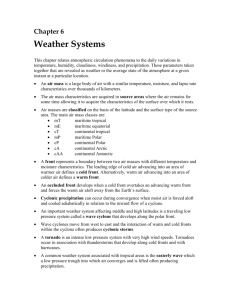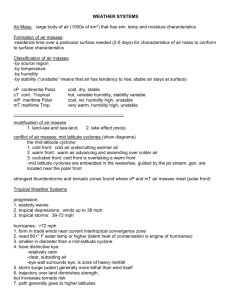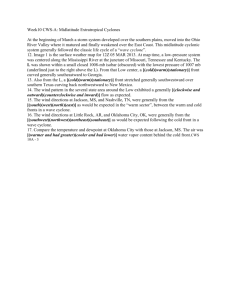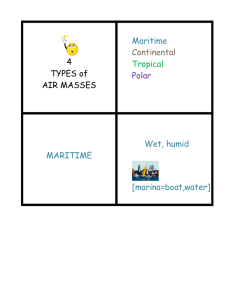On-Line Study Guide
advertisement
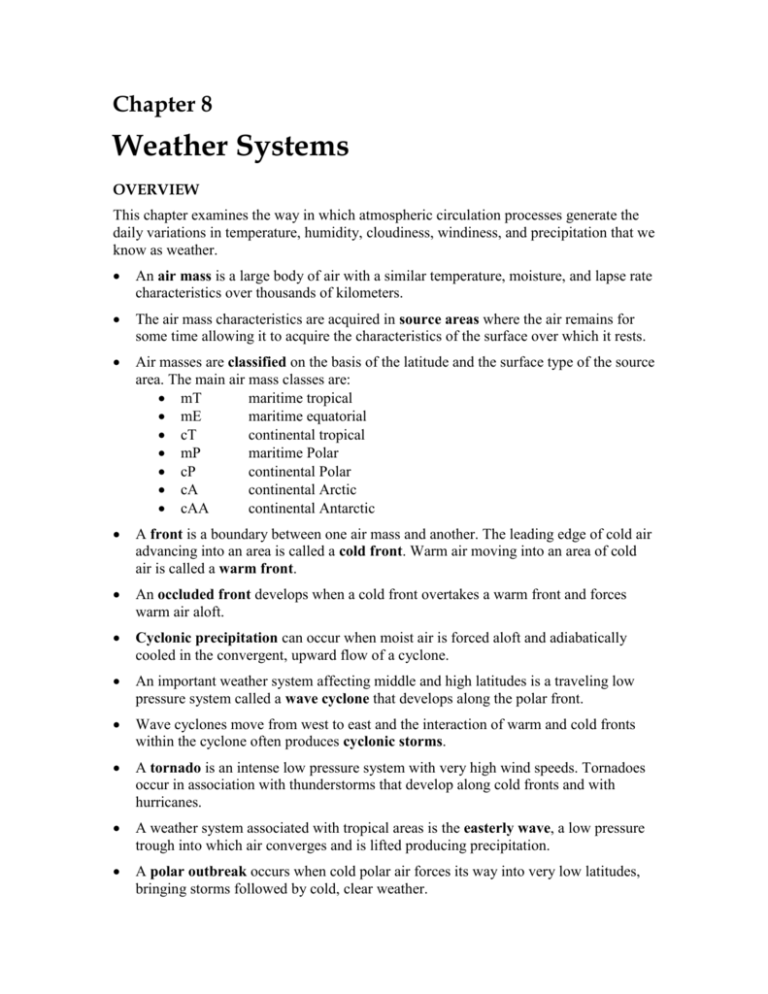
Chapter 8 Weather Systems OVERVIEW This chapter examines the way in which atmospheric circulation processes generate the daily variations in temperature, humidity, cloudiness, windiness, and precipitation that we know as weather. An air mass is a large body of air with a similar temperature, moisture, and lapse rate characteristics over thousands of kilometers. The air mass characteristics are acquired in source areas where the air remains for some time allowing it to acquire the characteristics of the surface over which it rests. Air masses are classified on the basis of the latitude and the surface type of the source area. The main air mass classes are: mT maritime tropical mE maritime equatorial cT continental tropical mP maritime Polar cP continental Polar cA continental Arctic cAA continental Antarctic A front is a boundary between one air mass and another. The leading edge of cold air advancing into an area is called a cold front. Warm air moving into an area of cold air is called a warm front. An occluded front develops when a cold front overtakes a warm front and forces warm air aloft. Cyclonic precipitation can occur when moist air is forced aloft and adiabatically cooled in the convergent, upward flow of a cyclone. An important weather system affecting middle and high latitudes is a traveling low pressure system called a wave cyclone that develops along the polar front. Wave cyclones move from west to east and the interaction of warm and cold fronts within the cyclone often produces cyclonic storms. A tornado is an intense low pressure system with very high wind speeds. Tornadoes occur in association with thunderstorms that develop along cold fronts and with hurricanes. A weather system associated with tropical areas is the easterly wave, a low pressure trough into which air converges and is lifted producing precipitation. A polar outbreak occurs when cold polar air forces its way into very low latitudes, bringing storms followed by cold, clear weather. Tropical cyclones, hurricanes, and typhoons are all names for powerful storms which develop over warm ocean surfaces between 8° and 15° latitude, migrate westward, and curve toward the poles. Tropical cyclones often create tremendous damage due to high winds, high waves, flooding, and heavy rains. The atmospheric circulation transfers heat and moisture from equatorial regions toward the Polar Regions by the Hadley cell circulation and Rossby waves. The thermohaline circulation within the oceans is another important mechanism by which heat is transferred from the equatorial to the polar regions of the Earth. An important element of climatic change studies is the positive and negative feedbacks between surface temperature and cloud cover. KEY TERMS cyclonic precipitation cyclonic storm wave cyclone air mass cold front warm front cyclone tracks occluded front tornado easterly wave polar outbreaks polar front tropical cyclone storm surge poleward heat transfer global warming storm surge STUDY QUESTIONS 1. What two variables provide the basis for air mass classification? 2. List six kinds of typical air masses and their source regions. 3. How do cold fronts differ from warm fronts? 4. Describe the formation of a wave cyclone. 5. List the important features of a tornado. 6. How do the easterly wave and the weak equatorial low produce precipitation? 7. What is a polar outbreak? 8. Describe a tropical cyclone. 9. What type of damage is often associated with a tropical cyclone? 10. What oceanic and atmospheric processes cause heat to be transferred to the poles? 11. What questions are scientists trying to answer regarding the feedback between global warming, atmospheric moisture, and cloud cover? CHAPTER QUIZ Multiple Choice Questions 1. Which of the following air masses would be described as very warm and moist? a) mE b) cT c) mP d) cP 2. The storm with the highest wind speeds is: a) wave cyclone b) tornado c) tropical cyclone d) easterly wave 3. Which of the following statements is not true about tropical cyclones? a) They only form poleward of 8° latitude. b) They are an intense low pressure system. c) They have a characteristic circular shape. d) They form in all of the tropical areas of the world. 4. Cirrus cloud may indicate: a) a cold front is approaching b) a warm front is approaching c) an occluded front is approaching d) none of the above. 5. At a warm front a) warm air is advancing against cold air b) cold air is advancing against warm air c) warm air moves faster than cold air d) both b and c are correct True/False Questions 1. 2. 3. 4. 5. The coldest air masses are mP air masses. (T/F) Warms fronts often create severe thunderstorms. (T/F) Tornadoes occur most frequently in the United States. (T/F) Traveling anticyclones are often associated with cloudy, wet weather. (T/F) A typhoon and a hurricane are identical in physical structure and properties although they occur in different parts of the world. (T/F) Short Answer Questions 1. What atmospheric processes send heat towards the poles? 2. What direction do wave cyclones travel? Why? 3. Why is the easterly wave not a circular weather system? Short Essay Questions (1 - 2 paragraphs) 1. Discuss the type, source area, and characteristics of the air masses affecting North America. 2. Describe the changes in weather that would take place if a wave cyclone passed through your area. 3. Describe the development and impacts of a tropical cyclone. Internet Resources 1. Description of air masses affecting North America: <http://www.usatoday.com/weather/tg/wamsorce/wamsorce.htm> 2. Extreme convective wind events as natural disasters: <http://hpccsun.unl.edu/nebraska/convective_main-ndcsp99.html> 3. Maps of hurricane tracks and other hurricane data: <http://weather.unisys.com/hurricane/index.html> 4. Slide presentation of fronts associated with cyclones (depressions): <http://atschool.eduweb.co.uk/radgeog/metlink/ppt/depression/HTML/sld001. htm> 5. Excellent interactive presentation of hurricane formation and structure: <http://www.cla.sc.edu/geog/faculty/carbone/modules/mods4car/tropcycl/index.ht ml>
